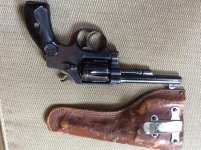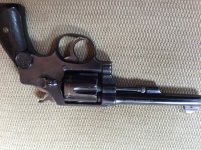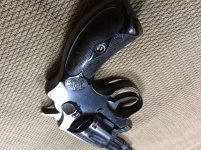You have a very nice family heirloom to be handed down to your grand children and GG children with its provenance and history as known to you, written down and kept with it for future generations.
OLD GUN CLEANING AND SAFETY CHECK PROTOCOL FOR HEIRLOOMS & NEW GUN OWNERS:
Simply put, the only usual issue with these marvels of yesteryear is they are gummed up and dirty. Old oils of its time do not match the quality of these old guns nor the science of today, and actually dry up and harden to the point of impeding operation and accelerating wear. The simple solution does not need a gunsmith or removal of the side plate. Just one of many premium modern gun care products from any sporting goods, gun store or hardware store.
Most are both cleaning and preserving agents; Breakfree, Kroil & M-Pro7 are some of the best, and there are others, but do not use WD-40. Disassembly is not necessary. With grips removed and a spray can version of the product, flood and flush the revolver thru every opening and crevice until the black gunk stops flowing out, let it drain for an hour and wipe it down thoroughly with the same product.
Scrub barrel bore and cylinder chambers with a simple cleaning rod kit found at the same places as the cleaning agents above; patches cut from rags is all you really need. And scrub any observed exterior and crevice crud with an old toothbrush with bristles cut off short for stiffness.
You have a quality made, very well engineered, assembled with skilled craftsmanship, and hand fitted revolver, no longer affordable to produce on a competitive market basis, and the likes of which we'll never see again, ever.
To remove grips: loosen the grip screw completely and carefully push down on the screw head until the bottom grip separates, then remove. Now carefully push the top side grip off with a finger or toothbrush from the backside thru the grip frame.
An application of wax, Renaissance wax is a popular one, will enhance and protect the finish if you want something to do while watching the news!
Once cleaned and lubricated, with a few simple checks you can determine if it’s safe to use; no need to waste time and money on a gunsmith, especially if you don't know one. Open the cylinder and verify the barrel is unobstructed. Cock the hammer in single action mode. Gently push on the hammer to confirm that it will not drop w/o pulling the trigger. Cock the hammer slowly and confirm the cylinder locks in position for each of the 6 chambers about the same time the hammer cocks. If satisfactory, now operate the gun in DA pulling the trigger slowly; again confirm the cyl locks before the hammer drops. After each cycling of the action, confirm that the cyl is still locked in position.
Cylinders can have fore and aft movement and rotational movement. Check rotational movement with the hammer cocked just to make sure it won’t skip to another chamber. That's all that is really important from a safety concern. Then unless you experience 'spitting' at the barrel/cyl gap when fired, you have no reason for concern.
You have a quality made, very well engineered, assembled with skilled craftsmanship, and hand fitted revolver, no longer affordable on a competitive market basis, and the likes of which we'll never see again, ever.
Shoot it to your hearts delight, and it will delight you with its fine accuracy, and comfortable recoil.
Any current off the shelf ‘standard’ factory loaded ammo is loaded safely for use in these old guns.









